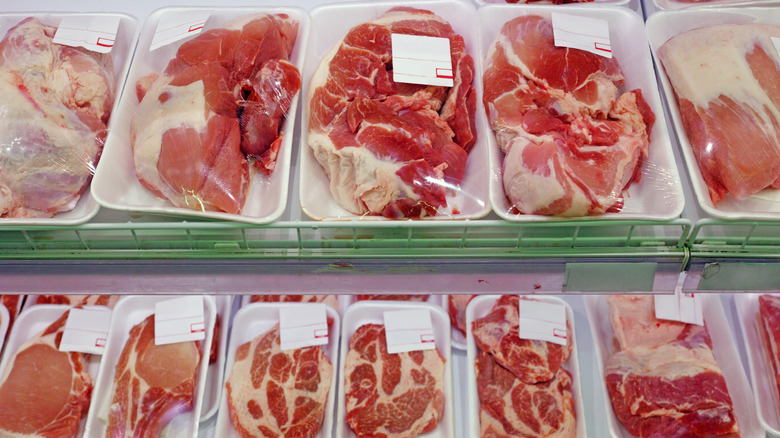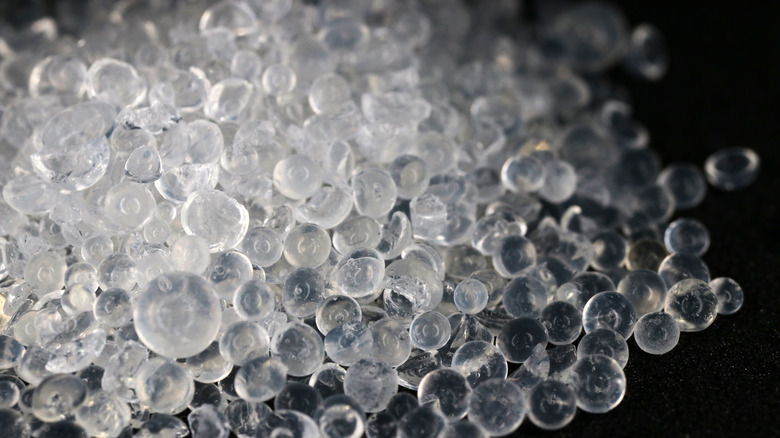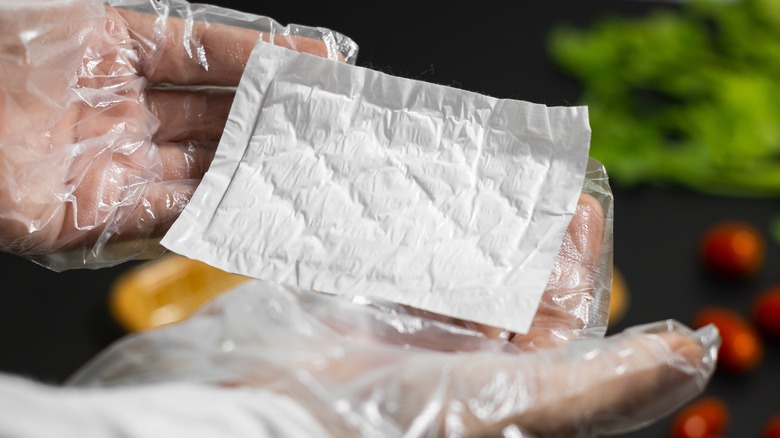We Finally Know What That Absorbent Pad In Meat Packages Is
Have you ever wondered why your meat wears a diaper? That absorbent pad that rests beneath every piece of pre-packaged meat is the kind of thing that doesn't cross your mind until you're making a big pot of chili, dump in the ground beef, and accidentally let that little pad fall into the mix. Now you've got to extract it from a pot of sizzling meat delicately, and by the time you finally get it out, you may be left wondering whether you've just poisoned your dish.
That little meat diaper can be annoying, but it exists for your safety. Raw meat lets out a lot of liquid (it's often mistaken for blood, but it's a mixture of water and myoglobin), and that liquid can harbor potentially dangerous bacteria such as Salmonella, Yersinia, and E. coli. Properly cooking your meat should protect you from any risk, but what if you spill some of the juice on your counter, or what if it leaks out of the packaging in your refrigerator?
These scenarios could lead to disaster, but the absorbent pad in each package of meat can hold up to 40 grams of liquid, trapping it between its layers and keeping it from contaminating other things. It also serves a cosmetic purpose because who wants to buy meat swimming in stagnant juices? Now that you know why your meat wears a diaper, it's time to find out what that pad is made of.
Meat diapers contain silica or cellulose
Most of the absorbent pads used in meat packaging are made from one of two materials. The first is silica gel, the same little beads you find in almost all product packaging, typically wrapped in a packet with "DO NOT EAT" printed boldly across it. Silica (a.k.a. silicon dioxide) is the same material that quartz crystals are made of and is extremely porous. Silica gel can absorb moisture, and that's why you find it in all kinds of products. Since it absorbs liquid, it also keeps the humidity in product packaging low, preventing spoilage and moisture damage.
Alternatively, the absorbent pad under meat might contain cellulose, a fiber found in plant cells. Cellulose can be made into highly porous beads, like silica gel, for absorptive purposes. No matter which absorbent material is used for the pad, it is typically sealed between two layers of perforated nontoxic plastic. These absorbent pads are subject to FDA oversight, and tight regulations regarding which materials can be used are in place. The FDA ensures that none of the materials used in the packaging have the potential to leach harmful chemicals into the meat, but there is one way that the plastic could hurt you.
Always remove the pad before cooking
Let's revisit the scenario where you're making a pot of chili and accidentally drop the meat diaper in with the ground beef. Do you need to panic about silica or cellulose leaching into your chili? The short answer is no, but remember to remove the pad before cooking because it could become dangerous if it melts. From the daunting, all-caps warning on silica gel packets, you might assume that absorbent pads made with silica are extremely dangerous to eat, but they aren't quite as scary as you'd think. According to the Arizona Poison and Drug Information Center, our bodies cannot absorb silica, so it passes through our digestive system without effects. The labels aren't warning us about the gel specifically; they're warning us about eating the whole packet, which can cause you to choke.
Cellulose packaging is even less of a concern. We eat cellulose daily, as it is a component of fruits and vegetables. The real concern with cooking meat pads is that the plastic layers could melt under the heat. According to the USDA, if you accidentally leave the absorbent pad in with your meat and it melts, you need to discard your food for safety's sake. However, as long as the pad stays intact, neither its exterior nor its interior contents should cause you any harm.


